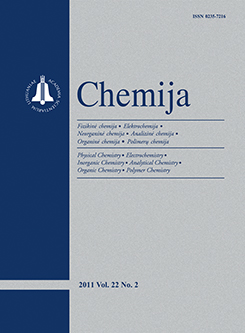 ISSN 0235-7216 ISSN 2424-4538 (online) |
2011 m. Nr. 1 Kinetics of removing chromium complex dye from acidic aqueous solutions employing anion exchange resins
The kinetics of removing the chromium complex dye Lanasyn Navy M-DNL from model solutions, using the acrylic matrix gel type weak base anion exchanger Purolite A 845 and a polystyrene matrix, the macroporous type I strong base anion exchanger Purolite A 500P has been investigated in batch experiments with respect to solution concentration and temperature. The kinetics studies, combined with optical microscopy, were conducted to reveal the relation between the physical-chemical characteristics of the anion exchangers and their performance in the removal of the chromium complex dye. The chromium complex dye sorption mechanism onto both anion exchangers investigated consists of ion exchange, physical sorption and diffusion. Kinetic parameters such as the external mass transfer coefficient ks, intraparticle diffusion coefficient ki and the rate constants of chemical sorption k2 for the dye – Purolite A 845 and dye – Purolite A 500P systems were studied using the Weber and Morris intraparticle diffusion model equations and the pseudo-second-order kinetic equation, respectively. The activation energies such as external mass transfer Ea–ks, intraparticle diffusion Ea–ki and chemical sorption Ea–k2 for dye–anion exchanger systems were calculated using the Arrhenius relationship. The intraparticle diffusion activation energy Ea–ki for the dye – Purolite A 845 system was 4.7-fold lower that for the dye – Purolite A 500P system, resulting in a deeper diffusion of the dye in the bead of the gel type weak base anion exchanger. Keywords: anion exchanger, chromium complex dye, sorption, kinetics, diffusion |
Issues:
2017 - Vol.28 No. 1, No. 2, No. 3, No. 4 2016 - Vol.27 No. 1, No. 2, No. 3, No. 4 2015 - Vol.26 No. 1, No. 2, No. 3, No. 4 2014 - Vol.25 No. 1, No. 2, No. 3, No. 4 2013 - Vol.24 No. 1, No. 2, No. 3, No. 4 2012 - Vol.23 No. 1, No. 2, No. 3, No. 4 2011 - Vol.22 No. 1, No. 2, No. 3, No. 4 2010 - Vol.21 No. 1, No. 2-4 2009 - Vol.20 No. 1, No. 2, No. 3, No. 4 2008 - Vol.19 No. 1, No. 2, No. 3-4 2007 - Vol.18 No. 1, No. 2, No. 3, No. 4 2006 - Vol.17 No. 1, No. 2-3, No. 4 2005 - Vol.16 No. 1, No. 2, No. 3-4 2004 - Vol.15 No. 1, No. 2, No. 3, No. 4 2003 - Vol.14 No. 1, No. 2, No. 3, No. 4 2002 - Vol.13 No. 1, No. 2, No. 3, No. 4 2001 - Vol.12 No. 1, No. 2, No. 3, No. 4 |